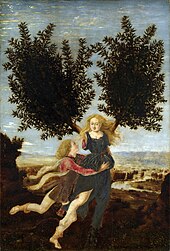Daphne: Difference between revisions
Reverted 2 edits by McSly and 66.27.52.166 to an older version by 66.27.52.166 (HG) |
No edit summary |
||
| Line 7: | Line 7: | ||
A famous rendition of the subject is [[Apollo and Daphne (Bernini)|Gian Lorenzo Bernini's ''Apollo and Daphne'']]. |
A famous rendition of the subject is [[Apollo and Daphne (Bernini)|Gian Lorenzo Bernini's ''Apollo and Daphne'']]. |
||
Daphne was here. (Hello [[WCATY]] class Building an Empire!) |
|||
==Notes== |
==Notes== |
||
{{reflist|2}} |
{{reflist|2}} |
||
Revision as of 03:04, 3 April 2009
It has been suggested that Apollo and Daphne be merged into this article. (Discuss) Proposed since September 2008. |

According to Greek myth, Apollo chased the nymph Daphne (Greek: Δάφνη, meaning "laurel"), daughter either of Penus and Creusa in Thessaly,[1] or of the river Ladon in Arcadia.[2] The pursuit of a local nymph by an Olympian god, part of the archaic adjustment of religious cult in Greece, was given an arch anecdotal turn in Ovid's Metamorphoses,[3] where the god's infatuation was caused by an arrow from Eros, who wanted to make Apollo pay for making fun of his archery skills and to demonstrate the power of love's arrow. Ovid treats the encounter, Apollo's lapse of majesty, in the mode of elegaic lovers,[4] and expands the pursuit into a series of speeches. Daphne prays for help either to the river god Peneus or to Gaia, and is transformed into a laurel (Laurus nobilis): "a heavy numbness seized her limbs, thin bark closed over her breast, her hair turned into leaves, her arms into branches, her feet so swift a moment ago stuck fast in slow-growing roots, her face was lost in the canopy. Only her shining beauty was left."[5] The laurel became sacred to Apollo, and crowned the victors at the Pythian Games.[6] Most artistic impressions of the myth focus on the moment of transformation.

A version of the attempt on Daphne's sworn virginity that has been less familiar since the Renaissance was narrated by the Hellenistic poet Parthenius, in his Erotica Pathemata, "The Sorrows of Love". Parthenius' tale was known to Pausanias, who recounted it in his Description of Greece (second century CE).[7] In this, Daphne is a mortal girl fond of hunting and determined to remain a virgin; she is pursued by the lad Leucippos, who assumes girl's clothes in order to join her band of huntresses. He is so successful in gaining her innocent affection, that Apollo is jealous and puts it into the girl's mind to stop to bathe in the river Ladon; there, as all strip naked, the ruse is revealed, as in the myth of Callisto, and the huntresses plunge their spears into Leucippos. At this moment Apollo's attention becomes engaged, and he begins his pursuit.
A famous rendition of the subject is Gian Lorenzo Bernini's Apollo and Daphne.
Daphne was here. (Hello WCATY class Building an Empire!)
Notes
- ^ Hyginus Fabulae 203.
- ^ Pausanias viii.20.1; Johannes Tzetzes Ad Lycophron 6; Philostratus, Life of Apollonius of Tyana i. 16.
- ^ Ovid, Metamorphoses i. 452; the treatment is commonly viewed as an Ovidian invention: see H. Fränkel, Ovid: A Poet Between Two Worlds (1945) p 79, or E. Doblhofer, ""Ovidius Urbanus: eine Studie zum Humor in Ovids Metamorphosen" Philologus 104 (1960), p. 79ff; for the episode as a witty transposition of Calvus' Io, see B. Otis, Ovid as an Epic Poet 2nd ed. 1970, p. 102
- ^ W.S.M. Nicoll, "Cupid, Apollo, and Daphne (Ovid, Met. 1. 452 ff.)" The Classical Quarterly, New Series, 30.1 (1980;174-182).
- ^ Translation by A. S. Kline, 2000.
- ^ Pausanias, x.7.8..
- ^ Pausanias viii.20.2.
External links
